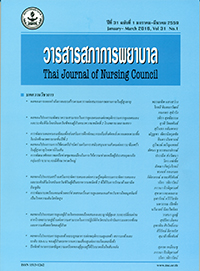การพัฒนาศักยภาพเครือข่ายชุมชนเมืองในการให้ความช่วยเหลือ ผู้ประสบอุทกภัยกลุ่มเปราะบาง: กรณีศึกษาหาดใหญ่
Keywords:
การพัฒนาศักยภาพ, เครือข่ายชุมชนเมือง, ผู้ประสบอุทกภัย, กลุ่มเปราะบาง, อาสาสมัครสาธารณสุข, potential development, urban network, flood victims, vulnerable inhabitants, public heath volunteersAbstract
บทคัดย่อ: วัตถุประสงค์ของการวิจัย : เพื่อวิเคราะห์ 1) ต้นทุนทางสังคม ปัจจัยสู่ความสำเร็จและอุปสรรค ในการพัฒนารูปแบบการเสริมสร้างศักยภาพเครือข่ายอาสาสมัคร 2) ศักยภาพของอาสาสมัครชุมชนเมือง ในการช่วยเหลือผู้ประสบอุทกภัยกลุ่มเปราะบางในพื้นที่น้ำท่วมซ้ำซาก อำเภอหาดใหญ่
การออกแบบการวิจัย : การศึกษาวิจัยและพัฒนา
วิธีดำเนินการวิจัย : กลุ่มตัวอย่าง จำนวนทั้งหมด 108 รายประกอบด้วย 1) ประชาชนกลุ่มเปราะบาง และผู้ดูแลที่อยู่ในพื้นที่เสี่ยงต่อน้ำท่วมซ้ำซาก 2) อาสาสมัครสาธารณสุข (อสม.) 3) เจ้าหน้าที่ศูนย์สาธารณสุข และเทศบาลนครหาดใหญ่ การเก็บข้อมูลแบ่งเป็น 3 ระยะคือ ระยะเตรียมการและวางแผนพัฒนา ระยะปฏิบัติการ และระยะประเมินผล ใช้วิธีการสัมภาษณ์ สนทนากลุ่ม สังเกตแบบมีส่วนร่วม และใช้แบบสอบถาม ข้อมูลที่ได้ นำมาวิเคราะห์ข้อมูลด้วยสถิติเชิงบรรยายและวิเคราะห์เนื้อหา (content analysis) สำหรับข้อมูลเชิงคุณภาพ
ผลการวิจัย : พบว่าปัจจัยที่เป็นต้นทุนสู่ความสำเร็จในการพัฒนาระบบเครือข่ายชุมชนเมือง คือ อสม. โดยมีมากกว่าครึ่งของผู้เข้าร่วมโครงการ (ร้อยละ 55.7) เป็นผู้ที่มีถิ่นฐานเดิมอยู่ในพื้นที่เสี่ยงต่อ น้ำท่วมซ้ำซาก ทุกคนมีจิตอาสาที่จะช่วยเหลือกลุ่มเปราะบางในชุมชน และมีแผนงานช่วยเหลือประชาชน กลุ่มเปราะบางเป็นรายบุคคล ภายใต้การดูแลของเจ้าหน้าที่ศูนย์สาธารณสุขในแต่ละชุมชนซึ่งมีประสบการณ์ ในการช่วยเหลือผู้ประสบอุทกภัย มีการควบคุมกำกับและซ้อมแผนการช่วยเหลือประชาชนกลุ่มเปราะบาง ร่วมกับ อสม.อยู่เป็นประจำเทศบาลมีแหล่งสนับสนุนด้านงบประมาณ มีการจัดตั้งบ้านพี่เลี้ยง มีแผนงาน ช่วยเหลือผู้ประสบอุทกภัยที่บรรจุอยู่ในแผนประจำปีชัดเจน และจัดให้มีการซ้อมแผนการช่วยเหลือทุกปี ส่วนปัจจัยที่เป็นอุปสรรคในการพัฒนาระบบเครือข่ายชุมชนเมือง คือสัดส่วนของ อสม.ในแต่ละชุมชน ยังไม่เหมาะสม การประสานระหว่างหน่วยงานต่างๆยังไม่มีโครงสร้างที่ชัดเจน อสม.เพียงร้อยละ 19.4 มีประสบการณ์ให้การปฐมพยาบาลแก่ผู้ประสบอุทกภัย และ อสม.เกินครึ่งไม่เคยมีประสบการณ์ในการ ปฐมพยาบาล (ร้อยละ 59.3) ไม่มีประสบการณ์การเป็นบ้านพี่เลี้ยง(ร้อยละ 54.6) และ ไม่มีประสบการณ์ ในการอพยพกลุ่มเปราะบางในชุมชน (ร้อยละ 63.0) จึงมีความต้องการเรียนรู้เพิ่มเติมในเรื่องการปฐมพยาบาล กลุ่มเปราะบางหลายเรื่อง อย่างไรก็ตาม ความรู้และทักษะของ อสม.หลังเข้าร่วมโครงการการพัฒนาศักยภาพ อสม.ในการช่วยเหลือผู้ประสบอุทกภัยกลุ่มเปราะบาง สูงกว่าก่อนเข้าร่วมโครงการ (p<.05) สรุปได้ว่า รูปแบบการพัฒนาศักยภาพเครือข่ายชุมชนเมืองเป็นการขับเคลื่อนด้วยความร่วมมือจากสามภาคีมี อสม.เป็นต้นทุนหลักสำคัญที่นำไปสู่ความสำเร็จ
ข้อเสนอแนะ: ผลการศึกษานี้สามารถพัฒนาเป็นต้นแบบที่นำไปขยายหรือต่อยอดการพัฒนา ศักยภาพเครือข่ายชุมชนเมืองในการช่วยเหลือผู้ประสบอุทกภัยกลุ่มเปราะบางที่อยู่ในบริบทหรือมี คุณลักษณะเดียวกัน และทดสอบประสิทธิภาพในสถานการณ์จริง
Abstract: Objective: To examine (1) social capital, success factors, and obstacles in relation
to developing a competent volunteer network, and (2) an urban volunteer network’s potential
for helping groups of inhabitants susceptible to recurring floods in Had Yai district.
Design: Research and development.
Implementation: This study was conducted on a sample of 108 flood-related people,
consisting of (1) flood-susceptible inhabitants, as well as local caretakers, of chronically
flooded areas; (2) community volunteers; and (3) public health and Had Yai municipality
officials. Data were collected in 3 stages: (1) preparation and planning of a development project;
(2) implementation; and (3) evaluation. Data collection was through interviews, group discussions,
participatory observation and a questionnaire. Descriptive statistics and content analysis
were adopted for analysing the quantitative and qualitative data, respectively.
Results: The major factor contributing to the capital for success in establishing an urban
network was the community volunteers. Constituting more than half (55.7%) of the participants,
these volunteers were originally from chronically flooded areas. Every such volunteer showed great
willingness to assist the communities’ susceptible inhabitants, with a plan to offer aid that responded
to each inhabitant’s needs, under supervision by each community’s public health officials with long
flood-relief experience. In addition, the officials, together with community volunteers, regularly
monitored their flood-relieving drills. The municipality’s support was in the forms of budgets,
mentor stations, and annual flood-relief plans, with flood-relieving drills being exercised every year.
Three main obstacles to urban network establishment were observed in this study. The first
was the disproportion of the number of volunteers and the number of inhabitants in each community.
The second was the lack of a clear coordination schema between organisations. The last concerned
the volunteers’ experience. Only 19.4% of the volunteers were experienced in helping flood victims.
Over half of the volunteers (59.3%) possessed no nursing care experience and 54.6% lacked
mentoring experience, whilst 63% were without any experience in evacuating susceptible members
of a community. Consequently, additional nursing-care training would be needed for volunteers
working with susceptible inhabitants. However, after completing the project, the volunteers exhibited
significantly higher levels of knowledge and skills needed for assisting susceptible inhabitants
(p < .05). It can be concluded, therefore, that this trilateral urban volunteer network, with
local volunteers being the principal operators, has promising potential for further application.
Recommendations: The outcome of this study could be applied to the other forms of
urban network development to provide aid and care for victims of floods or other disasters.
However, efficiency test in real situations is advised.
Downloads
References
Disaster Web. (2012). Flood in the Southern region.
Retrieved 25 June 2013, from http://paipibat.
com/? page_id=1726. (in Thai)
Meteorological Department (no date of printing).
Flood. Retrieved 8 Aug 2014, from URL: http://
www.tmd.go.th/ info/info.php?FileID=70. (in Thai)
Thongtua, K. , Chantramanee, C. & Thahom, U.
(2009). Community and disaster management in
flood area. Ubolrachathani: Asian Cities Climate
Change Resilience Network. (in Thai)
Songwathana, P., Kitrungrote, L., Koopantawee, N.
& Sornsrivichai, V. (2013). Disaster management in
a public health sector: community perspectives in Southern
Thailand. Proceedings at the 2013 International Nursing
Conference on Health, Healing, & Harmony: Nursing
Values 1-3 May, 2013 Phuket Orchid Resort and
Spa, Phuket, Thailand. (in Thai)
Institute for Population and Social Research, Mahidol
University. (2012). Assessing and developing social
assistance system in crisis situation Research and
Development Report Bangkok: Nathapon Place. (in Thai)
Training and Development of Public Health, North-
Eastern Thailand. (2010). Refresher Training Curriculum
for Village Health Volunteers (VHVs) in 2010.
Retrieved 10 June 2013, from http://www.esanphc.
net/vhv/files/Curriculum_VHV_2553.pdf.
Prince of Songkla University. (2012). Disaster
management in public health sector project: A case
study in southern Thai experiences. Available from
http://medipe2.psu.ac.th/~disaster/k4dm/. (in Thai)
Office of the Public Sector Development Commission.
(2007). Participatory Governance. Available from
http://www.opdc.go.th/content.php?menu_id=
&content_id=708. (in Thai)
Kamal, A., Songwathana, P. & Sae-sia, W. (2012).
Knowledge and skills of Emergency Care During
Disaster for Community Health Volunteers: A Literature
Review. Nurse Media J Nurs, 2(2), 371-381.
Department of disease control, Ministry of Public
Health. (2011). Manual for prevention of flood
related disease. Bangkok: The War Veterans
Organization of Thailand. (in Thai)
Julakiat, B. (2003). Emergency management in mass
casualty. In Sudapan Chanthira and Wanida Ooprasertsak.
(Eds) Nursing in emergency and mass casualty (pp.
-504). Bangkok: Nursing Department Mahidol
University. (in Thai)
Buajaroen, H. (2013). Management of health care
services for flood victims: the case of the shelter
at Nakhon Pathom Rajabhat University central
Thailand. Australasian Emer Nurs J, 16, 116-122
Kamal, A. (2012). A comparative of knowledge
and perceived skills regarding emergency care during
disaster between community health volunteers working
in tsunami-affected and non-affected areas in aced
province, Indonesia (Master’s thesis). Prince of Songkla
University, Thailand.
Kajornnan, N. (2009). Strategic management. (new
version) Bangkok: Sea-Ed Yukation. (in Thai)
Graduate Volunteer Institution, Thummasart University.
(2012). Living with water: Disaster victims’ response
on flood. Bangkok: Thummasart University. (in Thai)
Centers for Disease Control and Prevention. (2012).
Emergency Preparedness and Response. Retrieved
Sep 2013, from http://emergency.cdc.gov/
disasters/floods/readiness.asp.







